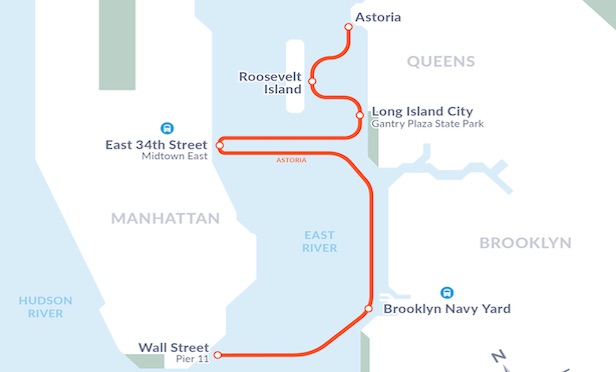 NYC Ferry/ photo by Paul Reuter BRIC
NYC Ferry/ photo by Paul Reuter BRIC
NEW YORK CITY—The New York City ferry now drops off and picks up passengers near Rudin Development Company and Boston Properties' Dock 72. Hornblower NY, which operates the ferry, now includes the 16-story, 250 foot-high, 675,000-square-foot development along the route that runs from Astoria, Roosevelt Island, Long Island City, and E. 34th Street to Wall Street at Pier 11. The Brooklyn Navy Yard stop is between the Wall Street/ Pier 11 and E. 34th Street stops.
 New York City Ferry route/ map provided by NYCEDC
New York City Ferry route/ map provided by NYCEDCNYC Ferry riders can transfer for free to all other ferry routes at the E. 34th St. and Wall Street ferry terminals. The public can access the Brooklyn Navy Yard ferry landing at BLDG 77, which is at the intersection of Flushing and Vanderbilt avenues. The passenger fare for a ferry ride is $2.75.
The Brooklyn Navy Yard currently employs 9,000 people according to the New York City Economic Development Corporation. The organization's president and CEO James Patchett says, “The addition of the Brooklyn Navy Yard landing is our first ferry stop at the dedicated job center, and we know it will help boost access to jobs, schools, and other neighborhoods while shortening commutes and creating new opportunities for New Yorkers.”
The yard is also where the ferry fleet is housed and maintained.
“NYC Ferry service at the Navy Yard provides a critical new transportation option for our tenants and will connect thousands of workers to our growing business district,” says David Ehrenberg, president and CEO of the Brooklyn Navy Yard.
As an anchor tenant, WeWork has leased 220,000 square feet across six floors at Dock 72. The ferry transportation comes during a $1 billion expansion effort to transform Brooklyn Navy Yard into a manufacturing and jobs center, with a goal of creating an additional 11,000 jobs in the district. In addition, EDC notes that the Navy Yard's master plan is striving for new manufacturing and creative office buildings to create up to 30,000 jobs.
The Citizens Budget Commission report Swimming in Subsidies states that the average subsidy per passenger during the ferry's first year was $10.73. This was the second highest taxpayer subsidy for city public transit. The report also notes the ferry system transports fewer people in one year than the subway does in one day.
The report projects with an expansion of the route to Coney Island, the required subsidies will reach $24.75 per ride. In an April 17, 2019 article in The New York Times, the city states the subsidies will decrease as more riders take the ferries. The article notes the cost of starting up the ferry service to all five boroughs would be close to $650 million.
EDC emphasizes the need to link boroughs by the waterways to connect people to jobs at the Brooklyn Navy Yard. The non-profit also points out the ferry provides a transportation option to Navy Yard tenants and nearby residents including New York City Housing Authority residents.
New York City controller Scott Stringer has objected to the city's $82 million purchase of the boats which Hornblower operates, as well as the subsidies. In early April, he called upon the department of transportation to take over the NYC Ferry, citing a need for greater transparency, accountability and fiscal responsibility. In the media, Stringer is now at times referred to as a potential mayoral contender for 2021.
© Touchpoint Markets, All Rights Reserved. Request academic re-use from www.copyright.com. All other uses, submit a request to [email protected]. For more inforrmation visit Asset & Logo Licensing.







